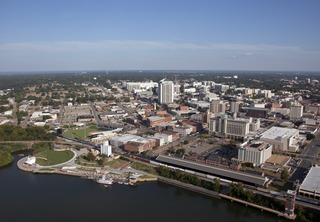
Montgomery is the capital city of the U.S. state of Alabama and the county seat of Montgomery County. Named for Continental Army Major General Richard Montgomery, it stands beside the Alabama River, on the coastal Plain of the Gulf of Mexico. The population was 200,603 at the 2020 census. It is now the third most populous city in the state, after Huntsville and Birmingham, and is the 128th most populous in the United States. The Montgomery Metropolitan Statistical Area's population in 2022 was 385,460; it is the fourth largest in the state and 142nd among United States metropolitan areas.

Lee County is a county located in east central Alabama. As of the 2020 census the population was 174,241. The county seat is Opelika, and the largest city is Auburn. The county was established in 1866 and is named for General Robert E. Lee (1807–1870), who served as General in Chief of the Armies of the Confederate States in 1865. Lee County comprises the Auburn-Opelika, AL Metropolitan Statistical Area, which is included in the Columbus-Auburn-Opelika, GA-AL Combined Statistical Area.

Eufaula is the largest city in Barbour County, Alabama, United States. As of the 2010 census the city's population was 13,137.
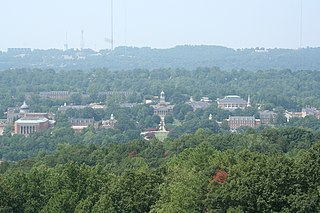
Homewood is a city in southeastern Jefferson County, Alabama, United States. It is a suburb of Birmingham, located on the other side of Red Mountain due south of the city center. The population was 26,414 at the 2020 census.

Phenix City is a city in Lee and Russell counties in the U.S. state of Alabama, and the county seat of Russell County. As of the 2020 Census, the population of the city was 38,817.

Livingston is a city in and the county seat of Sumter County, Alabama, United States and the home of the University of West Alabama. By an act of the state legislature, it was incorporated on January 10, 1835. At the 2010 census the population was 3,485, up from 3,297 in 2000. It was named in honor of Edward Livingston, of the Livingston family of New York.

Salem is an unincorporated community east-centrally located in Lee County, Alabama, United States. It lies along U.S. Routes 280 and 431 between Opelika and Phenix City. It is part of the Auburn Metropolitan Area.

This is a list of the National Register of Historic Places listings in Russell County, Alabama.
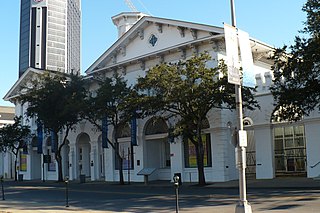
Old City Hall, also known as the Southern Market, is a historic complex of adjoining buildings in Mobile, Alabama, that currently houses the History Museum of Mobile. The complex was built from 1855 to 1857 to serve as a city hall and as a marketplace. It was declared a National Historic Landmark in 1973, as a rare well-preserved example of a 19th-century multifunction civic and commercial building.
Girard, Alabama was a city in the far north-east corner of Russell County, Alabama across the Chattahoochee River from Columbus, Georgia.

Seale is an unincorporated community in Russell County, Alabama, United States. It was the county seat from 1868 until 1935, and is currently home to Russell County High School and middle school. The former Russell County courthouse, built in 1868, is located in the town.
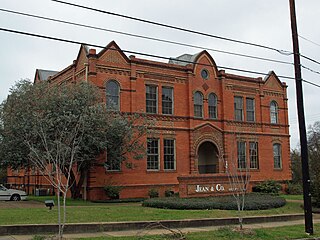
The Sayre Street School building is located at 506 Sayre Street, in an older residential neighborhood near downtown Montgomery, Alabama. The school was originally built in 1891 by builder J. B. Worthington and served as office space until 2017. The building and surrounding landscape, now abandoned and neglected, have fallen into a state of major disrepair.

The Bama Theatre is a historic theatre in Tuscaloosa, Alabama that currently serves as the city's performing arts center. Its modern redevelopment is the result of cooperation between the Arts Council of Tuscaloosa and the Tuscaloosa County Parks and Recreation Authority. The three-story brick and limestone building is located at the corner of Gary Fitts Street and Greensboro Avenue in downtown Tuscaloosa. It was added to the National Register of Historic Places (NRHP) on August 30, 1984. It is also a contributing building in the Downtown Tuscaloosa Historic District, NRHP-listed in 1985.

Lincoln School is a historic school building in Huntsville, Alabama. Built in 1929 as part of the Lincoln Mill Village, the school became part of the city school system in the 1950s. The city sold the building to a private school in 2011. It was listed on the National Register of Historic Places in 1982.

This is a list of the National Register of Historic Places listings in Mobile, Alabama.

There are eight properties listed on the National Register of Historic Places (NRHP) in Linn County, Kansas. Two of the sites are the location of historic events. The Marais des Cygnes Massacre Site is the location of the Marais des Cygnes massacre, an 1858 event during Bleeding Kansas in which pro-slavery advocates kidnapped 11 anti-slavery settlers, killing five of them. John Brown temporarily used the site as a fort, and the property was listed on the NRHP in 1971. The Battle of Mine Creek Site preserves the location of the Battle of Mine Creek, which was fought in 1864 as part of Price's Raid during the American Civil War. Confederate general Sterling Price's army was retreating after being defeated at the Battle of Westport and was attacked by pursuing Union troops. Price's Confederate lost heavily in men and supplies. The site was added to the NRHP in 1973.
Frederick Albert Hale was an American architect who practiced in states including Colorado, Utah, and Wyoming. According to a 1977 NRHP nomination for the Keith-O'Brien Building in Salt Lake City, "Hale worked mostly in the classical styles and seemed equally adept at Beaux-Arts Classicism, Neo-Classical Revival or Georgian Revival." He also employed Shingle and Queen Anne styles for several residential structures. A number of his works are listed on the U.S. National Register of Historic Places.
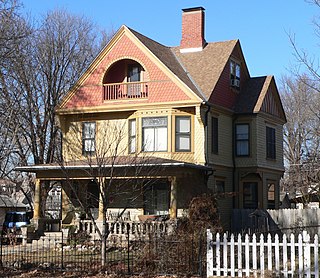
The James D. Calhoun House is a historic house in Lincoln, Nebraska. It was built in 1889 by Charles W. Bean for James D. Calhoun, who served in the Confederate States Army during the American Civil War of 1861-1865 before moving to Nebraska, where he was the editor of the Lincoln Weekly Herald from 1887 to 1894 and the Nebraska State Journal from 1880 to 1886. The house was designed in the Queen Anne style from plans published by architect Robert W. Shoppell. It has been listed on the National Register of Historic Places since April 26, 2002.
The Brownville–Summerville Historic District is a historic district in Phenix City, Alabama. The district covers approximately 87 acres (35 ha) of mostly residential area to the west and northwest of the city's commercial core. The earliest houses in the district date from circa 1870, and are either Greek Revival or Saddlebag cottages. Beginning in the 1880s, many Victorian cottages were built by employees at the town's cotton mills and iron works. In the 1920s and 1930s, bungalows continued to be built. Several commercial buildings, most brick and dating from the 1920s, are scattered throughout the district.

Fort No. 5 is a historic American Civil War fort in Phenix City, Alabama. It was built in 1863 as one of eight forts for the defense of Columbus, Georgia, which was a major producer of war materiel for the Confederacy. The pentagonal fort is 30 yards (27 m) per side, with earthen walls. During the Battle of Columbus on April 16, 1865, the Confederate army was badly undermanned, and Fort No. 5 was left unoccupied as the Union Army captured Columbus.



















